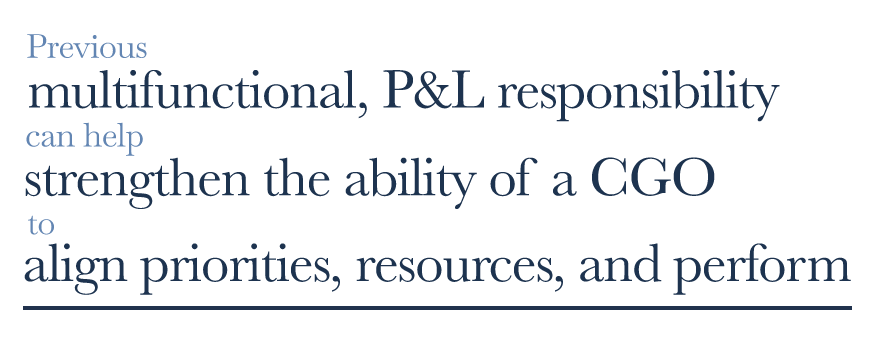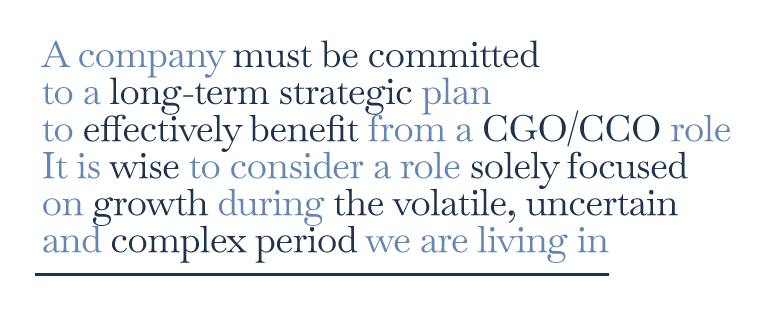2021 Market Landscape: CMO, CGO & BU President – Roles, Responsibilities, and Interactions

How to Select and Maximize Impact for My Organization With One or More of These Roles
As we move further into the digital age, consumers are increasingly in control of how and when they interact with brands via advertising, social channels, and more – and the 2020 pandemic has only caused further disruption in an already vastly changing landscape. In response, we are witnessing a rise in the scope and overall presence of Chief Growth Officer and Chief Marketing Officer roles, and companies that enact these positions are likely to be ahead of the curve moving forward. With expertise spanning marketing, revenue generation, and the associated human capital needs, ZRG is uniquely positioned to recruit the leaders your organization needs to capture sustainable growth in 2020 and beyond.
The Situation
- Consumer, Industrial, Tech, Life Sciences, Healthcare, Professional Services, Education, Not-for-Profit … Name a sector and companies are wrestling to declare their “Pandemic Pivot” and generate sustainable growth.
- Ongoing investor pressure for greater performance, dramatic changes in consumer behavior and preference, and a channel and customer landscape that has been reshaped are a few of the driving forces.
- Growth aspirations have been derailed in many sectors. Even ahead of the pandemic, innovation (breakthrough or even product) has lagged. Cost-cutting and “3G-ing ahead of the activists” have diverted top-line attention. Many of these initiatives were necessary, but no one is going to pave a way to greatness with these strategies.
- The market is becoming increasingly more “activated” via digital touchpoints. Customers and end users now choose when, where, and how to engage with brands. The brand focus is now the Consumer, not the product or service.
- Higher scope of authority and accountability is demanded and necessary to ensure timely decisions that will impact results in the short and long term.
- Greater understanding of the consumer, speed and agility to adapt to new trends, and innovation to maintain a leading edge are expected in the millisecond decision-making process of the Information Age. Leads today are expected to be driven by precision.
- In this pursuit, many leading companies have redesigned the role of Chief Marketing Officer and created the position of Chief Growth or Commercial Officer at a corporate level. This carries implications of how the marketing function is managed, how it collaborates across functions, the value it should bring, and its accountability internally and externally. Simply put, this is a major change in marketing.
- Many world-class organizations have been asking the right questions about how to better structure their “growth drivers"
- What are other comparable companies doing?
- Do we really need a Chief Marketing Officer at an enterprise level?
- How does that role differ from Business Unit marketers?
- Where should sales leadership reside?
- Do we need a corporate Head of Sales?
- How do we effectively present “one voice” to large customers?
- Who reports into who?
- What is the role of the Chief Digital/Transformation Officer? Where do these roles report?
- Who leads eCommerce?
- How do these roles intertwine?
- Who is accountable for what?
- Do we have knowledge at the board level to inform marketing investments?
- Who manages the agencies, creative, innovation, new product development, etc.?
- Where should brand management reside?
- Who should lead innovation and consumer insights?
- How should the role engage with other functions, e.g., Finance, Supply Chain, Corporate Affairs?
- The right answer is that there is no one right answer. The solution is as individual as the customers and consumers you are trying to reach. Each company is driven by its own situation and business cycle. Aligning marketing strategy and all its tools against business strategy will be paramount. Those that do not take the time to use brand strategy solutions as a business driver will fall behind in the long run. The starting point is a change in company culture to ensure that the transformation of your business model is successfully implemented over time.
The Market Overview
Historically, multi-business unit companies operating domestically or multi-nationally have a corporate Chief Marketing Officer. However, that role is gradually giving way to a more commercially driven Chief Growth or Commercial Officer.
- The Chief Growth or Commercial Officer combines multiple skills ranging from a President with P&L accountability to operations and marketing. It is a position supported heavily by the CEO and ideally one that has a strong path as the CEO successor. The role requires a leader that can influence, see what is not there, and create a bond with P&L leaders who now have brand marketing under their structure.
- The traditional organizational structure viewed the CMO role as “Chief Branding Officer” responsible for leading creative and overall communication across all channels. Anything that touches the customer, consumer, or end user went through the CMO. We see this role in decline and evolving into a marketing, operations, and shared services function (largely to drive online and offline media-buying efficiencies).
- Many organizations came to realize that marketing at the corporate level is a cost center, and their role in the value chain, although critical, must be in parallel to today’s ultra-high-speed business landscape. Agility and speed are keynotes, as is speed and the ability to stay close to your customers and consumers, anticipating and responding to their needs before someone else does. You either disrupt or you will be disrupted. Thus, demand generation marketers should reside in the Business Units.
- Many companies have a matrixed structure for corporate and BU marketing and have designed a transparent model for their marketing operations.
- Corporate CMO (reporting to CGO) – Center of Excellence, shared services, marketing operations; brand equity, agency relationships, innovation, insights.
- BU “CMO” – Directly tied to business performance and reporting directly to the BU President; responsible for demand generation and brand activation. Closely tied to sales and operations. Metrically driven.
- Many companies have Presidents that have grown their careers in commercial functions, primarily marketing. Presidents made a career choice to pursue a general manager route and have P&L responsibility, but they still need a great marketer on their team.

What Does that Mean?
A fully dedicated resource for growth helps to manage volatile, uncertain, complex, and ambiguous opportunities. It can also reduce internal friction within channels and with customers. This is a “demand generation” and “revenue generation” role. The ideal leader should break silos, incorporating competencies across functions, bridging communication gaps, and ideally having had a President or General Manager role in their career trajectory to provide credibility as they propose directions, align priorities, and influence the future of the organization.

The absence of a Chief Growth Officer may inhibit your ability over time to understand and segment consumers at the speed, depth, breadth, and accuracy that you require to keep driving the trends and forging the capabilities around them that will ensure your ability to deliver sustainable performance within your sector. It may also hinder the chances to foster timely innovation that will differentiate your company and position it for accelerated growth.
Does My Company Really Need a CGO/CCO?
Evidence indicates CGO/CCO roles work best when company BUs sell through the same channels and the company strategy requires forward-looking vision with a three- to five-year horizon. If a company is not committed to the long-term plan, installing a CGO/CCO could be problematic and costly.
Further, the role is not as effective (and can get in the way) if each BU sells through segregated channels or to disparate customers. In these cases, an enterprise “Marketing Operations” role can help manage brand equity and marketing expenses, and growth can reside primarily in the hands of the BU President, BU Head of Sales, and BU Head of Marketing.
Role Definitions
Chief Growth or Commercial Officer
- Develop strategic demand (customer/consumer) and revenue generation (customer) strategies building on consumer and customer insights
- Work closely with the Head of Sales to develop channel strategies
- Optimize resources for:
- Consumer insights and innovation
- Digital strategy
- Agency and media resources
- Data analytics
- Customer teams
- Develop expertise to ensure:
- Brand DNA is clearly identified, communicated, and followed
- Cross-fertilization opportunities are maximized
- Key strategic brand decisions for future competitiveness are timely and made with a greater degree of knowledge
These measures should safeguard the equity of the brands, limiting their elasticity and enabling them to absorb price changes with limited risk of market share erosion.
President
- P&L responsibility
- 24- to 36-month focus
- Multi-function reporting, starting with Sales and BU Marketing
- Accountability
- Topline revenue
- Customer and channel strategies and execution
- Consumer and customer marketing activation
- Activity calendar
- Go-to-market strategy and execution
- Promotional initiatives
- Innovation: near-term product focus
- Finance functions*
- Supply chain and operations functions*
- HR business partners*
- R&D*
*Each functional leader will consistently interface with their corporate-level counterparts to align priorities, challenges and opportunities, and execution. Dotted and solid lines may vary by function, but accountability remains with the President.
What Bridges Across Both Marketing and Growth?
Collaboration: Ongoing trust, credibility, and dialogue between the CGO and the Presidents are the key ingredients for success. This element is supported and encouraged by the CEO, who may be called at any moment to break a deadlock, should one surface.
Human Capital Strategy
- Actively participate in aligning functions and teams around a common cause, the consumer. Establishing a culture of “better together” is essential.
- Assess what consumers want and where you want to deliver on their expectations. The Ideal goal is to develop a structure in parallel. A culture that supports people in a constant state of change is key.
- Don’t over-complicate. Design a structure in which people take ownership and feel empowered and engaged.
- Ensure that there is clear strategy and vision, well-defined accountability, and ongoing transparent communication. Most importantly, make sure these are communicated well.
- Recruit leaders who play to win versus play not to lose. Innovation and growth go hand in hand. Remaining insular within an industry does not help. Build thinking and cultural diversity.

|
